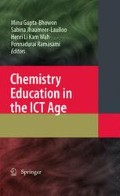Abstract
The purpose of this study was to investigate the effectiveness of using computer simulations on students’ understanding of “Atomic Structure and Bonding” over the traditionally designed instruction. The impact of computer simulations on students’ attitude and motivation was also studied during the research. The study was carried out in a girls’ State Secondary School in Mauritius. The sample consisted of 44 students in two Form IV (students of age 14–15 years) Chemistry classes. One class (n = 21) represented the treatment group in which computer simulations were used to teach “Atomic Structure and Bonding” using the software “Atoms, Bonding and Structure” (an interactive Chemistry tutor). The other class (n = 23) comprised the control group in which the same topic was taught by the traditional expository instruction without the use of computer simulations.
Our findings have revealed an improved performance of students in the treatment group as compared to students in the control group. Furthermore, the study has also shown that students in the treatment group were very enthusiastic and highly motivated when computer simulations were used. Our results thus indicate that computer simulations have not only enhanced students’ understanding of “Atomic Structure and Bonding,” but also increased their motivation during the lessons.
Access this chapter
Tax calculation will be finalised at checkout
Purchases are for personal use only
References
Bowen CW (1998) Item design considerations for computer-based testing of student learning in chemistry. J Chem Educ 75:1172–1175
Ben-Zvi R, Eylon BS, Silberstein J (1986) Is an atom of copper malleable? J Chem Educ 63:64–66
Griffiths A, Preston K (1992) Grade 12 students’ misconceptions relating to fundamental characteristics of atoms and molecules. J Res Sci Teach 29:611–628
Gabel DL, Samuel KV, Hunn D (1987) Understanding the particulate nature of matter. J Chem Educ 64:695–697
Haider AH, Abraham MR (1991) A comparison of applied and theoretical knowledge of concepts based on particulate nature of matter. J Res Sci Teach 28:919–938
Abraham MR, Grybowski EB, Renner JW, Marek EA (1992) Understanding and misunderstanding of eighth graders of five chemistry concepts found in textbooks. J Res Sci Teach 29:105–120
Abraham MR, Williamson VM, Westbrook SL (1994) A cross-age study of understanding five chemistry concepts. J Res Sci Teach 31:147–165
Nakhleh MB (1992) Why some students don’t learn chemistry. J Chem Educ 69:191–196
Tsaparlis G (1997) Atomic and molecular structure in chemical education: A critical analysis from various perspectives of science education. J Chem Educ 74(8):923–925
Piaget J, Inhelder B (1969) The psychology of the child. Basic Books, New York
Ausubel DP (1968) Educational psychology – a cognitive view. Holt, Rinehart & Winston, New York
Novak JD (1984) Application of advances in learning theory and philosophy of science to the improvement of chemistry teaching. J Chem Educ 61(7):607–612
Williamson VM, Abraham MR (1995) The effects of computer animation on the particulate mental models of college chemistry students. J Res Sci Teach 32:521–534
Russel JW, Kozma RB, Jones T, et al (1997) Use of simultaneous, synchronized macroscopic, microscopic and symbolic representations to enhance the teaching and learning of chemical concepts. J Chem Educ 74:330–334
Means B, Olson K (1995) Technology’s role in education reform. http://www.ncrel.org/tplan/cbtl/execsum.htm. Accessed 17 March 2006
Ardac D, Akaygun S (2004) Effectiveness of multimedia-based instruction that emphasizes molecular representations on students’ understanding of chemical change. J Res Sci Teach 41(4):317–337
Stieff M (2005) Connected chemistry – A novel modeling environment for the chemistry classroom. J Chem Educ 82(3):489–493
Vygotsky LS (1978) Mind in society. Harvard University Press, London
Sanger MJ (2000) Using particulate drawings to determine and improve students’ conceptions of pure substances and mixtures. J Chem Educ 77:762–766
Somekh B (2001) The role of evaluation in ensuring excellence in communication and information technology initiatives. Edu Comm Info 1(1):75–101
Papert S (1980) Mindstorms, children computers and powerful ideas. Basic Books, New York
Rieber L (1990) Using computer animated graphics in science instruction with children. J Educ Psychol 82:135–140
Condie R, Munro B (2007) The Impact of ICT in Schools – A landscape review. Becta Research, Coventry
Acknowledgments
The authors kindly acknowledge and thank Ray Le Couteur, the designer of the “Atoms, Bonding and Structure” software used. Abdoolatiff also thanks Ray Le Couteur for allowing her to use the software for classroom teaching.
Author information
Authors and Affiliations
Corresponding author
Editor information
Editors and Affiliations
Rights and permissions
Copyright information
© 2009 Springer Science + Business Media B.V.
About this chapter
Cite this chapter
Abdoolatiff, S., Narod, F. (2009). Investigating the Effectiveness of Computer Simulations in the Teaching of “Atomic Structure and Bonding”. In: Gupta-Bhowon, M., Jhaumeer-Laulloo, S., Li Kam Wah, H., Ramasami, P. (eds) Chemistry Education in the ICT Age. Springer, Dordrecht. https://doi.org/10.1007/978-1-4020-9732-4_10
Download citation
DOI: https://doi.org/10.1007/978-1-4020-9732-4_10
Published:
Publisher Name: Springer, Dordrecht
Print ISBN: 978-1-4020-9731-7
Online ISBN: 978-1-4020-9732-4
eBook Packages: Humanities, Social Sciences and LawEducation (R0)

